There are two ways of using show laser light systems: Aerial or beam show applications and graphics/surface projections.
At aerial or beam shows, the spectators face the laser projector or at least spectate the laser beams from the side. The laser beams do not necessarily end on a certain surface.
Graphics projections use a surface to visualize graphics, texts etc. that are drawn by the laser. It is always necessary to have a surface where the graphics, texts, etc. are visualized on. As laser light is never ending (only getting dimmed), there is no way to do any projection without having a proper surface to project on. However, it is possible to use special projection surfaces that are not solid or have other features that help in creating 3D-like laser show projections.
Front-projection screens - rear projection screens
Front projection screens usually are made of solid screen material, like it is used for most of the video projections - at home or in cinemas. This material usually has very good reflection values and thus are very suitable for bright projections. The color of this screen type usually is white (to get the best reflection factor). If a front projection screen is used, spectators view the projection from the same direction the laser projector is drawing on the screen.
Rear projection screens are usually made of semi-transluminescent material, so they do not reflect the light but create kind of a "glow". Depending on the opacity, rear projection screens sometimes even let some portion of the laser beam pass through the material. The color of this kind of screens usually is light grey.
Projections on rear projection screens are made from the opposite side of the spectators - the laser projector faces the audience with having the rear projection screen in between, where the graphics, texts, etc. are projected on.

front projection screen
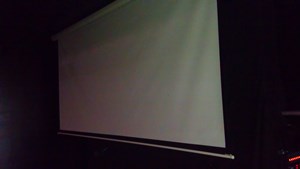
front projection screen

gauze projection - video and laser
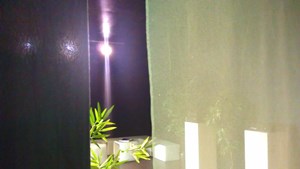
gauze screen (right side). clearly visible: transluminescence
Gauze projection screen / mesh projection screen
Gauze projection screens are made of kind of "fishnet" material, meaning the fabric has many small holes (mesh material, gauze material). Gauze screens can be used for front and rear projections at the same time. Due to the many holes the reflection values are not as good as with normal front projection screens, however there are other huge advantages - especially in combination with laser light projections: Due to the many small holes the laser beams are not only reflected or create a beam on the surface - parts of the beams can also pass through the material. Together with fog or haze in the room this gives a 3D like effect: The diverging beam makes the spectators feel like they would be integrated in th show.
The use of a gauze screen thus provides opportunities of both types of shows - for beam shows as well as for graphics/text shows.
Both types, the front and the rear projection screen, are very suitable for use with lasers. Especially the front projection screen gives great results if lasers are used together with video projections, e.g. for video mapping.
Gauze Screens / Mesh screens are available of different types of fabric/material: Most common is a medium grey screen type, but there are also special transparent materials available that give more of a glitter effect when projected on. The major difference basically is the size of the holes and the thickness of the gauze material. The material itself influences the reflection factor and the transluminescence.
Frosted glass
Where normal glass surfaces usually are not really suitable for laser projections (too low reflection value), frosted glass can be a very suitable alternative. The frost effect rpovides sufficient reflection for the use both as front as well as rear projection solution. This kind of projection surface is often used when it comes to projections towards buildings or if certain advertisement projections shall be made. The advantage of this kind of projection surface is that it can be seamlessly integrated in most designs objects, buildings, etc., but can easily be turned into a projection "screen".
The opacity and the kind of the frost effect heavily influence the suitability for laser projetions.
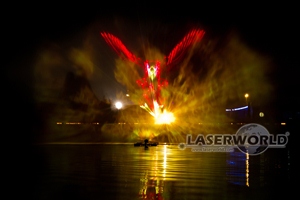
hydro shield projection
Hydro Shield projections
Hydro shields create a rather flat projection surface made of water. The shape of this screen is a half circle and is generated from the bottom upwards. It is created with a special 180° flat nozzle together with a very strong pump system. This kind of projection screen requires a permanent water source, and usually the nozzle element is placed in a lake or larger water basin. Hydro Shields are used for comibations of video and laser projections and are used with rear projection in most cases. Most of the huge multimedia shows use Hydro Shields as projection surfaces.
The huge advantage of these kind of projection surfaces is the variability: Hydro Shields can appear and disappear within seconds, whereas most common normal screens take much longer to move.
Diameters of up to 50m are possible with Hydro Shields, which makes them also suitable for large scale applications.
Waterscreens
Waterscreens consist of a nozzle element that is equipped with hundreds of nozzles in several rows. This element is mounted to the ceiling, truss, etc.. A pump delivers water from a water source to this element and makes water dripple out of the many holes. So the general principle of a water screen works opposite to the water shield: Whereas the water shield emerges from bottom upwards, the waterscreen is created of water drops drippling down - that's why some people also call it "water curtain". Water screens are normally used at indoor applications, hydro shields more for larger scale outdoor projections. With lasers it is possible to project on the water screen from both directions, video projections should face the spectators to be properly visible.
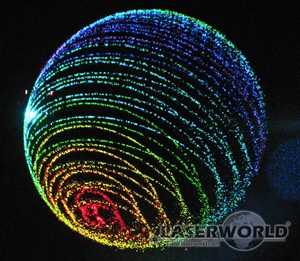
water screen projection
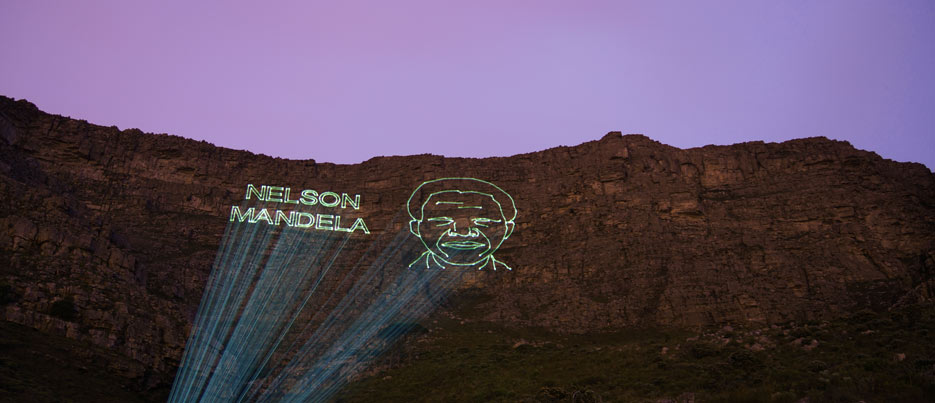
Projection on a mountain with trees
Walls, buildings, rocks, mountains
In many cases it is not possible to have a proper projection screen installed - already existing objects need to be used as "screen". Of course it is possible to use all different kinds of objects as projection surface, however some things need to be considered:
Laser Safety: Especially projections on reflecting or deflecting surfaces can be dangerous, as the laser radiation may be deflected in an unexpected way. Special precautions may be necessary.
Visibility: Some surfaces are not really suitable to project on as they are either of low reflecting material or not of enough density. Also too uneven surfaces may not be suitable.
Projections on buildings with glass facade are extremely tricky to nearly impossible, as the laser light is deflected and not reflected. If facade projections shall be done it is essential to have some solid surface, best is some white wall.
If the laser should shine a projection on a mountain or rock, it is important to aim it to an area where the surface is as steep as possible - vertical rock is best. The lighter the color of the stone/mountain surface, the better, if there is no environmental brightness. If there is dim light around, middle grey stone is best to project on.
If the mountain is covered with forest, it is rather tricky to get an even projection surface, feasibility needs to be determined more in detail.
Generally to say, it is best to have an even surface to shine the laser on.





Distributed brands: